Have you ever wondered why some gardeners insist on letting their potatoes flower before harvesting? "Should you allow potatoes to flower?" is a question many ask as they grow these tubers.
It might seem counter-intuitive, especially when the primary goal is growing robust tubers rather than fruit.
Our extensive research into whether or not to cut the flowers off your potato harvest may surprise you.
Yes! You should allow your potatoes to flower. Harvesting after the flower allows the potato plant to grow to its potential.
However, it's essential to note that not all potato varieties will bloom or bear fruit.
Independent of flowering, the optimal harvest time typically aligns with the yellowing and subsequent dying of the above-ground greenery.
Let's look at why you should let your potatoes flower, NOT cut them off, and how to get the best harvest.
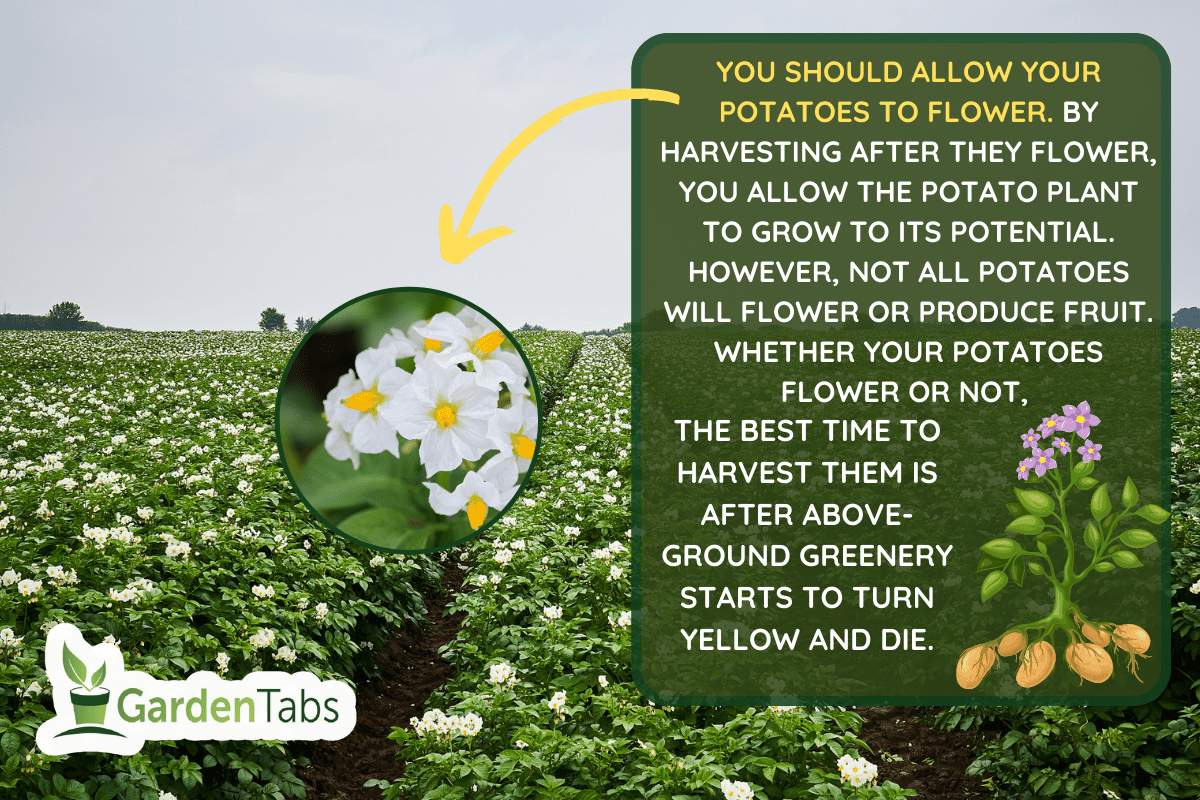
Why Are Potator Flowers Important?
Should you let your potato plants flower?
Yes, you should allow potatoes to flower. Flowering is a natural part of the potato reproduction cycle.
However, many potato varieties flower because they can reproduce through seeds.
If you have a flowering potato variety, you should let them bloom. This is a sign that it will be time to harvest your potatoes soon.
It is also an indicator that your potatoes are healthy, and you can potentially harvest seeds from the fruits your potato produces.
The most common way to grow potatoes is by planting seed potatoes. Seed potatoes are popular in part because they are easy to handle.
Understanding the beauty and importance of potato flowers can offer a deeper appreciation for this humble crop.
In the following sections, we'll dive into the numerous reasons to embrace those delicate blossoms in your garden.
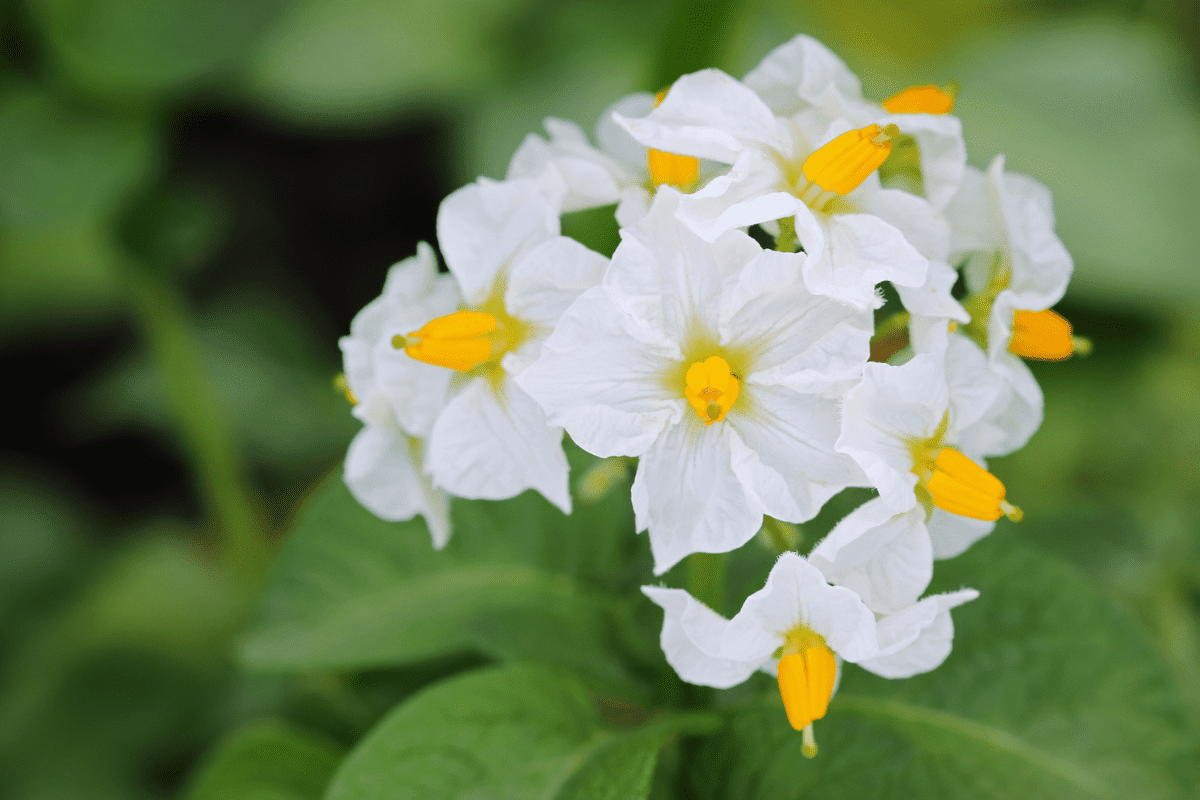
5 Reasons Why You Should Allow Potatoes To Flower
Have you ever gazed at a blossoming potato plant and wondered if those vibrant flowers had a purpose?
You're not alone!
Here are five compelling reasons to let your potatoes bloom freely.
Reason #1: Natural Growth Cycle Of Potatoes Includes Flowering
Potatoes have a predictable rhythm: they sprout, grow, flower, and eventually yield the delicious tubers we enjoy on our dinner plates.
These flowering stages are essential checkpoints in their life cycle.
By allowing potatoes to bloom, you're respecting and understanding this natural progression.
While there's a notion that snipping flowers might boost tuber growth, concrete evidence supporting this is lacking.
Next time you’re tempted to cut those blossoms, pause and consider the plant's natural journey.
Reason #2: Potato Flowers Are Nature's Readiness Alarm
Flowers are more than just beautiful; they're informative.
When potatoes begin to flower, it marks the initial phase of tuber growth.
However, once these flowers wilt, it clearly indicates that your potatoes are nearing full maturity.
Instead of relying on guesswork or calendar dates, these flowers serve as nature's very own readiness alarm.
So, while some gardeners believe in trimming flowers to enhance growth potentially, there's beauty in letting nature guide your harvest timing.
Reason #3: Monitor the Health of Your Potato Plants
A flourishing flower on your potato plant is akin to a thumbs-up sign.
When these plants produce vibrant flowers, they are signaling optimal health.
This indicates the perfect balance of sunlight, water, and nutrient-rich soil.
By removing these blooms, you might be depriving yourself of this easily visible health indicator.
And although there's a school of thought that advocates for flower trimming to promote tuber growth, the tangible benefits remain disputed.
Reason #4: Seed Harvesting For Next Year's Potato Crop
Beyond the immediate joy of a good harvest lies the promise of future crops.
The seeds found in the flowers of potato plants are the gatekeepers to the next generation of potatoes.
Especially for heirloom varieties, these seeds are invaluable.
They hold the genetic blueprints of unique traits cherished over generations.
Denying the plant its flowering phase means potentially missing out on collecting these seeds, a direct bridge to future harvests.
If sustainability and continuity are your goals, it is essential to allow the plant its complete flowering phase.
Reason #5: Attract Beneficial Insects
Potato flowers can attract beneficial insects to your garden. These beneficial insects include pollinators like bees and butterflies.
Not only do they help in the pollination of other plants in your garden, but they also help control pest populations.
Inviting such allies into your garden naturally reduces the need for chemical interventions and supports a balanced ecosystem.
Check out this video where a gardener shows us his Yukon Gold and Pontiac Red potato plants. He talks about using a special spray to help them grow and shows the beautiful flowers on the plants. These flowers can tell us if we'll get lots of potatoes.
Watch and see how he does it!
[Click to watch the video]
Maturity Indicators: When Is The Right Time To Harvest?
Understanding the signs of potato maturity is the key to harvesting them at their peak.
Several clear indicators will help you determine the right moment to dig up those precious tubers:
1. Yellowing Foliage
Just as the golden hue of autumn leaves signals the changing seasons, the yellowing of potato leaves is a hallmark of maturity.
When you notice a shift from vibrant green to a pale yellow, it's a clear sign the tubers are reaching their optimal size.
2. Dying Back of the Plant
Beyond the yellowing, the entire above-ground portion of the plant will display signs of wilting and decline.
This gradual withering is nature's way of signaling that the plant has done its job, and it's time for the tubers to be harvested.
3. Flower Appearance and Wilt
The blooming and subsequent wilting of potato flowers provide yet another hint.
Although flowering suggests the plant has reached its zenith in growth, the post-bloom phase is often the ideal window for harvesting.
Together, these signs form a triad of maturity indicators, guiding gardeners towards the ideal harvest time.
By being attentive to these markers, you can ensure a bountiful crop of well-formed and delicious potatoes.
Harvest Timing: Seizing the Optimal Moment
Harvesting potatoes isn't just about recognizing signs of maturity; it's about seizing the optimal moment to ensure the best quality tubers.
Factors like the potato variety and prevailing weather conditions can influence this timing:
Duration to Maturity: Most potato varieties will mature between 100 to 120 days after planting.
However, if you've started with seed potatoes, a shorter duration of around 50 to 55 days is typical.
Foliage and Flower Cues: As reiterated, once the plant's foliage turns yellow and starts to wither, and the flowers have gone through their lifecycle, it's your green light to begin harvesting.
Pre-Harvest Care: Post-flowering, it's advisable to reduce watering.
This reduction helps the skin of the potatoes thicken, making them less susceptible to damage during harvest and better for storage.
Timing is everything in gardening. And when it comes to potatoes, heeding these cues and guidelines can mean the difference between a good harvest and a great one.
Understanding The Potato Plant In Detail
Like every plant, potatoes have their unique characteristics, some of which may surprise you.
From their deceptive fruits to their flowering habits, every aspect of this plant displays nature's intricacies.
Let's explore.
Can You Eat The Fruits of a Potato Plant?
While the fruits of a potato plant might resemble small green tomatoes, they are not for consumption.
This is because potatoes share the nightshade family with tomatoes.
However, unlike the delicious fruits of their tomato cousins, potato fruits are toxic to both humans and pets.
Why are they toxic? Potato plants produce solanine, a protective compound that shields them from the harsh sun.
In certain circumstances, this compound can cause potatoes to develop green patches.
Any green part of the potato, from its skin to the leaves and fruits, is a potential solanine hotspot. When ingesting such parts, solanine poisoning is a risk.
What about the seeds? True potato seeds are found within these fruits, especially in heirloom varieties.
While they might be of value to researchers or plant breeders, it's worth noting that non-heirloom varieties may produce non-viable seeds.
You should test them before trying to plant them.
Do All Potato Varieties Flower?
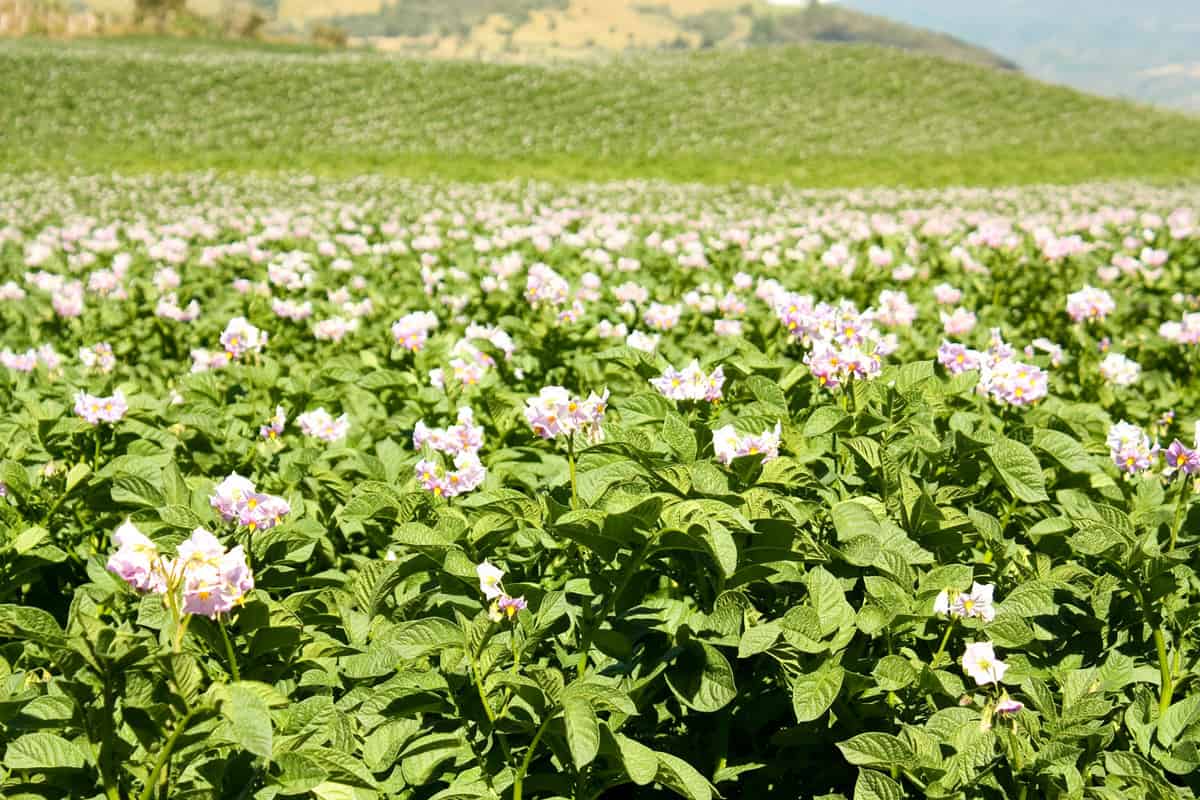
The flowering of potatoes is variety-dependent and can be influenced by environmental factors.
If you don't see your potatoes flowering, it's not a cause for concern.
In fact, some gardeners see this as advantageous, as the energy otherwise used for flowering can be redirected to tuber growth.
Harvesting Non-Flowering Potatoes
Whether your potatoes flower or not, watch for signs of readiness for harvest.
Typically, yellowing foliage, even if only partial, indicates readiness.
Some gardeners opt to harvest when a bit of green remains for easier extraction, while others wait for the entire plant to yellow and wither for maximum growth.
When Should Potatoes Flower?
Potatoes, like many plants, flower to facilitate pollination and seed production, signaling the latter stages of their lifecycle.
Typically, after about ten weeks in the ground, potato plants might flower, though this can vary based on the climate and potato variety.
Harvest Signals
The flowering phase denotes the potato plant's peak maturity. Upon seeing flowers, one can anticipate that the harvest is imminent.
Conventional wisdom advises harvesting soon after the flowers wither.
Additionally, reducing water intake at this stage can aid in hardening the potatoes, preparing them for harvest.
Harvesting: Best Practices And Common Questions When Growing Potatoes
Growing potatoes can be done in different ways, like in the ground or in containers.
Each way has its own benefits and challenges. Knowing about these can help us get a better harvest. Let's start by looking at one common question:
Should we dig up potatoes before they flower?
Can You Dig Potatoes Before They Have Flowered?
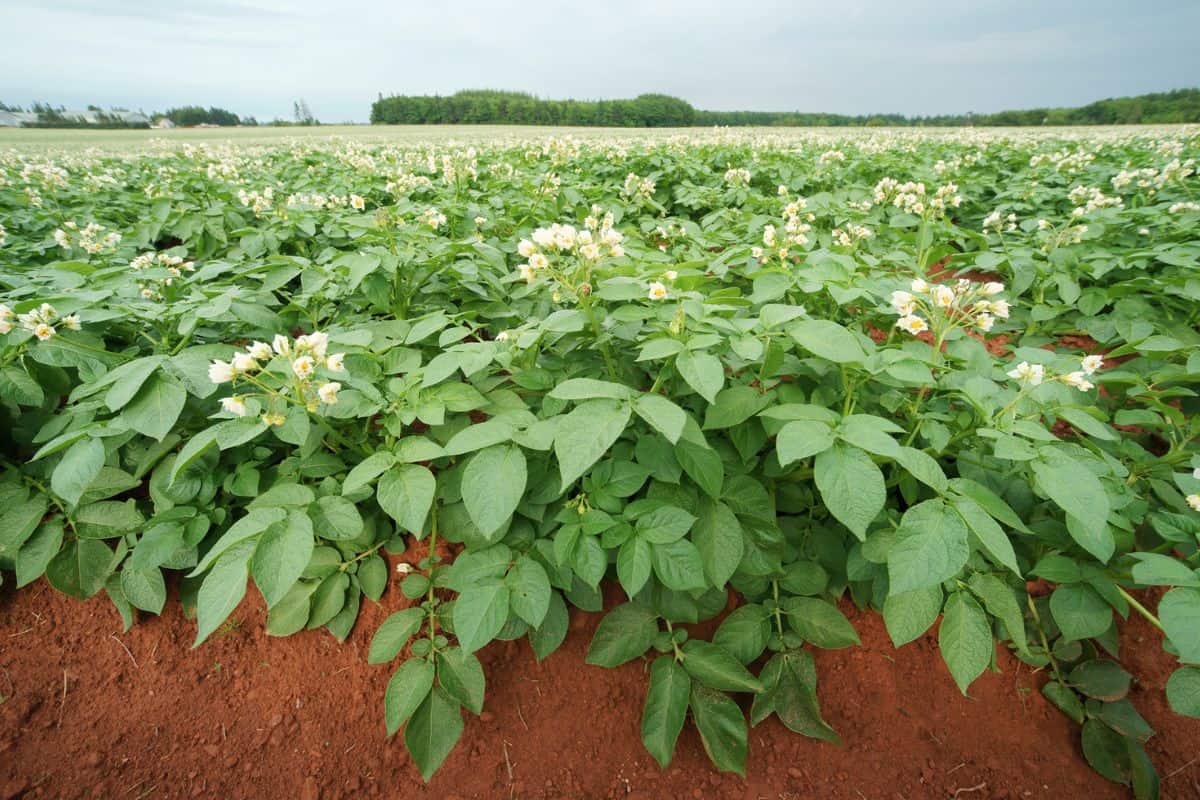
It's possible to harvest potatoes before they flower, but it might not yield the best results.
Size: Harvesting early usually results in smaller, baby potatoes since they've not reached their full growth potential.
Frost considerations: In anticipation of a prolonged frost, it might be wise to harvest early to ensure you get a yield rather than risking a total loss.
For short-term frosts, consider using a greenhouse or frost cover to protect the crop.
Click Here To See This Plant Cover On Amazon
Container Harvesting
Growing potatoes in containers is a practical solution for gardeners with limited space or poor soil.
Here are some steps and tips to help you harvest your container-grown potatoes successfully.
Step 1: Monitor for Maturity Signs
Yellowing Foliage: As with potatoes grown in the ground, the leaves of container-grown potatoes will turn yellow when the tubers are ready to be harvested.
Dying Back: The plant's above-ground parts will begin to wilt and die back, signaling the end of the growth cycle.
Flower Appearance and Wilting: When the plant blooms and the flowers subsequently die off, it's another sign that your potatoes are mature.
Step 2: Preparing for Harvest
Reduce Watering: Once the flowers appear, cut back on watering. This helps the potatoes harden and cure before harvesting.
Wait for Foliage to Die Back: After the plant's foliage has completely died back, wait an additional week to allow the skins of the potatoes to toughen up.
Step 3: Harvesting The Potatoes
Overturn the Container: Place a tarp or large piece of plastic on the ground and gently tip over the container, spilling out the soil and potatoes.
Search for Tubers: Carefully sift through the soil with your hands to find all the potatoes. Be gentle to avoid damaging the tubers.
Brush Off Soil: Gently brush off any excess soil from the potatoes. Avoid washing them, as moisture can cause them to rot during storage.
Step 4: Storing the Harvest
Curing: Allow the potatoes to cure by leaving them in a cool, dark, and well-ventilated area for about two weeks.
This helps the skin to harden further and any minor cuts to heal.
Storage: Store the cured potatoes in a dark, cool, humid environment, like a basement or cellar.
Use a container that allows for good airflow, like a burlap, paper bag, or basket.
Avoid storing potatoes in plastic bags, as they can trap moisture and cause the potatoes to rot.
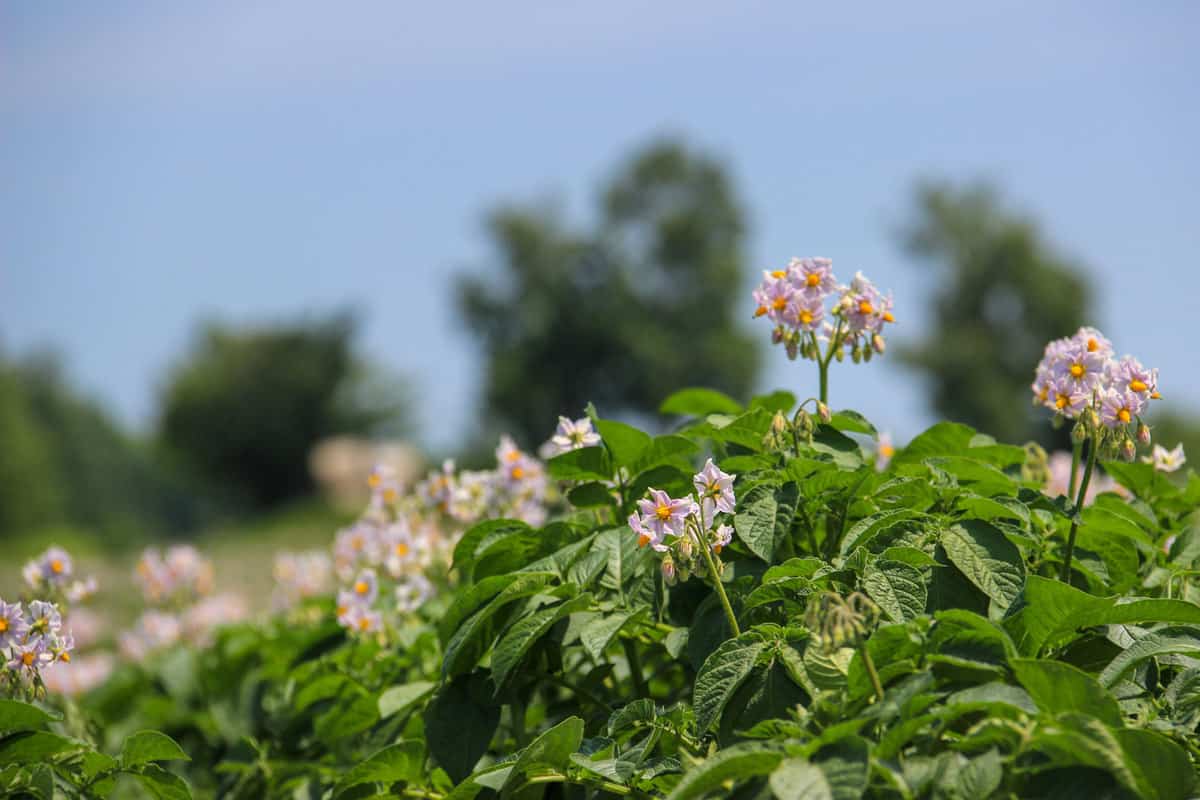
Consequences of Neglect: What Happens If You Don't Harvest Potatoes?
Unharvested potatoes have several potential fates:
Rot and Decay: Left in the ground, many potatoes will rot, especially if exposed to freezing conditions.
Regrowth: In warmer climates, they might survive winter and sprout anew the following season.
Natural Replanting: Neglected potato fruits can drop seeds, potentially growing new plants if conditions are right.
While allowing potatoes to rot isn't ideal, they can reintroduce nutrients to the soil.
However, for consistent yields and garden management, it's best to harvest and prepare seed potatoes for replanting.
Doing so gives you more control over your garden's production.
Wrapping Up: Your Potato Planting Journey
This comprehensive guide offered an in-depth look at potato planting.
We've answered the pressing question: should you cut potato flowers and why does it make a difference?
We've walked through the clear indicators that tell you when your tubers are ready for harvest.
And, for those eager to try container gardening, we provided steps to ensure a fruitful yield.
Remember, every gardening experience is a learning journey. Each potato plant, whether it flowers or not, offers valuable lessons.
As you nurture these plants, you also cultivate patience, resilience, and a deeper connection with nature.
Feel inspired? Why not share your potato growing stories in the comments below? We'd love to hear from you!
Further Reading
Want to learn more about potatoes and other vegetables? Grow your green thumb with these informational posts:
15 Vegetables That You Can Grow Indoors In Winter

